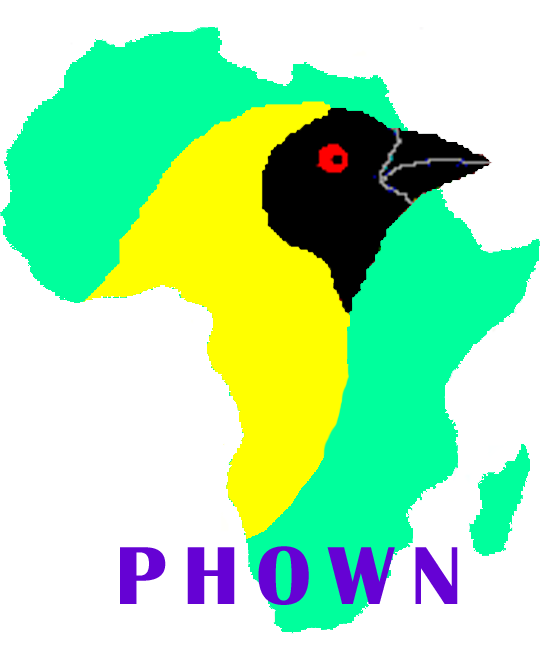Weaver news
| Smit B, Harding CT, Hockey PAR, McKechnie A. 2013. Adaptive thermoregulation during summer in two populations of an arid-zone passerine. Ecology in press. (http://dx.doi.org/10.1890/12-1511.1) Abstract. Heterothermy plays an important role in lowering the costs of thermoregulation in endotherms by reducing water and energy requirements. We tested predictions that birds in arid habitats should express fine-scale variation in their thermoregulatory patterns as a function of prevailing climatic conditions. We assessed the effects of air temperature (Tair) and water vapor pressure deficit (D) on body temperature (Tb) in free-living white-browed sparrow-weavers (Plocepasser mahali) during summer in two arid habitats in the Kalahari Desert, South Africa, using data from a dry period at a hot, desert site (n = 7), and a dry (n = 4) and a wet period (n = 5) at a milder, semi-desert site. The desert birds maintained a significantly (p < 0.001) higher set-point Tb (41.5 +- 0.2 C) than semi-desert birds (40.2 +- 0.2 C). During the warmest part of day (12:00 - 18:00 hours), Tb increased significantly during periods of high Tair and/or high humidity, and mean and maximum Tb were up to 1.4 and 2.3 C, respectively, above normal levels. However, as Tair increased, birds at the desert site maintained Tb at or below set-point levels for a greater proportion of the time than birds at the semi-desert site. Birds at the desert site also expressed a greater magnitude of daily heterothermy (mean Heterothermy Index, HI = 2.4 +- 0.3 C) than birds at the semi-desert site: the latter population showed a greater magnitude of heterothermy during a dry period (HI = 2.1 +- 0.3 C) than during a wet period (HI = 1.6 +- 0.2 C). Birds continued foraging throughout the warmest part of the day, despite the fact that heat dissipation (% time spent panting and wing-spreading) increased significantly with increasing Tair. Our findings reveal that populations can vary in their thermoregulatory responses in both space and time, and suggest that small changes in Tair can have significant effects on thermoregulation in free-ranging desert birds, even when Tair < Tb. These data have important implications for assessing vulnerability of species to climate change, suggesting that sensitivity should be assessed at the population, rather than species level.
Photo (left): from birdpix 482, for more photos of this species, see here. White-browed Sparrow-weavers were studied at two sites, 100 km apart, in the southern Kalahari Desert of South Africa. The semi-desert site was Tswalu Kalahari Reserve (27 19'S 22 25'E), studied from 1 December 2010 to 28 December 2010 and 14 January to 12 February 2011. The desert site, a more arid site, was Wildsgenot Game Ranch (27 04'S 21 23'E), studied from 21 November to 18 December 2011. The desert site is part of the most extreme climatic region occupied by the White-browed Sparrow-weaver across its southern African range. The birds were trapped at night (21:00 to 23:00 hours) in their roost nests using a hand net. All the birds were ringed with an aluminium ring and up to three colour rings for field identification. A registered veterinarian implanted temperature-sensitive dataloggers intra-peritoneally. The mean body mass of captured birds was 42.9 g (range = 35.8 - 51 g) and the implanted iButtons (1.76 - 2.05 g) weighed less than 5.5% of body mass in all individuals. As many birds as possible were recaptured one month after surgery, either by hand in their roosts or during the day using mist nets, to remove the iButtons surgically. A key finding of this study was the relatively large variation in Tb both within and between conspecific populations. This suggests that the thermal physiology of endotherms is more flexible than previously thought, and could potentially help populations to adapt to changing climatic conditions. In the past, predictions of species' vulnerabilities to climate change have relied mainly on bioclimatic envelopes which assume that physiological responses are species-specific. However, these findings suggest that a species' current range may not be an accurate representation of its climatic tolerance. Literature as featured in Weaver Watch news items |











